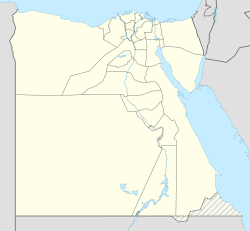上埃及
上埃及 | |||||||||
|---|---|---|---|---|---|---|---|---|---|
| 约公元前3400年 — 约公元前3150年 | |||||||||
| 首都 | 提尼斯 | ||||||||
| 常用语言 | 埃及语 | ||||||||
| 宗教 | 古埃及宗教 | ||||||||
| 政府 | 君主制 | ||||||||
| 国王 | |||||||||
• 约公元前3400年 | 蝎王一世(首任) | ||||||||
• 约公元前3150年 | 那尔迈(末任) | ||||||||
| 历史 | |||||||||
• 建立 | 约公元前3400年 | ||||||||
• 终结 | 约公元前3150年 | ||||||||
| |||||||||
| 今属于 | |||||||||
上埃及(阿拉伯语:صعيد مصر,罗马化:Ṣaʿīd Miṣr,简写为الصعيد,发音为[es.sˤe.ˈʕiːd];科普特语:ⲙⲁⲣⲏⲥ,罗马化:Mares),位于埃及南部,由尼罗河三角洲和北纬30度线以南的尼罗河河谷组成,包括从开罗以南到纳赛尔水库的尼罗河河谷。[2]
名称
[编辑]在古埃及,上埃及被称为“tꜣ šmꜣw”,[3] 也就是“芦苇之地”或“莎草之地”, 得名于种植在此处的纸莎草。[4]
在古希伯来语中,上埃及被称为פתרוס,ptrws,阿卡德语中则是Paturisi。[5]这两个名称均源于埃及语中的pꜣ-tꜣ-rsj,意思是“南方之地”。[6]
在阿拉伯语中,上埃及被称为“萨伊德”(Sa'id)或“萨希德”(Sahid),这两个词来自صعيد,意思是“高地”,这个词又来自صعد,意思是上升、升起。上埃及的居民通常被称为“萨伊德人”,而他们所讲的语言则被称为“萨伊德阿拉伯语”
地理
[编辑]
上埃及南至现代阿斯旺以外的尼罗河瀑布,向北则沿河延伸至如今的艾亚特(El-Ayait)地区。[7] 根据这个划分,现代开罗属于下埃及。上埃及的北部,即上埃及的下游部分,从索哈杰到艾亚特之间,也被称为中埃及。
历史
[编辑]人们认为,在涅伽达三期文化期间,一个可能存在的“提尼斯同盟”的统治者通过吸收对立城邦的方式实现了上埃及的统一。随后,上下埃及的统一标志着早期王朝时期的到来。[8]上下埃及在法老王权中融为一体。红白双冠就是上下埃及融合的一种形式。[9]古典时期之后,上埃及依然作为一个历史区域存在。
史前埃及
[编辑]尼肯是史前上埃及的一个主要城市。[10] 这里的守护神是描绘为秃鹫形象的奈赫贝特。[11]
约公元前3600年,尼罗河沿岸的新石器时代埃及社会开始以种植作物和驯养动物为文化基础。[12]之后不久,埃及社会开始向高度发展的文明社会迅速迈进。.[13]此时出现了一种新的独特陶器,与黎凡特南部的陶器相关联。[13]美索不达米亚的晒砖工艺以及包括拱形结构及凹墙装饰在内的建筑方式也流行起来。[13]
在上埃及,前王朝时期拜达里文化之后是涅伽达文化(阿姆拉特文化),[14]与下努比亚,[15][16][17][18]以及其他东北非洲人群、[19]马格里布沿岸社群、[20][21]部分热带非洲群体[22]以及可能来自中东的居民紧密相关。[23]
根据生物考古学家南希·洛夫尔(Nancy Lovell)的研究,古埃及人骨骼的形态学证据强烈表明:“总体而言,上埃及和努比亚的居民在生物学上与撒哈拉及更南部地区的人们有很强的联系”,但在非洲的整体背景中,也表现出了一些局部差异。[24]体质人类学家S.O.Y.基塔也对古埃及人的生物亲缘关系进行了研究,并将史前南埃及人的骨骼形态学描述为“撒哈拉-热带非洲变体”。基塔还补充说,尽管埃及社会变得更加复杂,生物学上也具有多样性,但“尼罗-撒哈拉-苏丹起源的族群特性并未改变。从目前可以确定的范围来看,文化规范、仪式方式以及用于书写的符号,仍然保持着其南方起源的特性。”[25]
原王朝时期的君主源自涅伽达地区。[26]在上埃及的希拉孔波利斯的挖掘中,发现了类似埃及以南更远的地区使用的仪式面具,以及与埃塞俄比亚采石场相关的黑曜石。[27]弗兰克·尤尔科(Frank Yurco)指出,与法老有关的图像,例如王冠、荷鲁斯鹰以及胜利场景主要集中在上埃及的涅伽达文化和努比亚A文化。他进一步解释道:“埃及的书写体系诞生于上埃及的涅伽达和下努比亚的A文化,而不是直接与西亚接触的三角洲文化。这进一步削弱了埃及直接受到美索不达米亚影响的观点。”[28]
同样,历史学家兼语言学家克里斯托弗·埃赫雷特(Christopher Ehret)指出,上埃及在第四个千年所出现的,宗教领袖制度与王权制度的文化实践,可以追溯到几个世纪之前的努比亚以及埃及以南的尼罗河中游地区。他根据考古学和比较民族学证据得出了这一观点。[29]
这些文化进步与尼罗河上游地区(即上埃及)城镇的政治统一同时发生,而同样的情况也出现在尼罗河三角洲地区(即下埃及)的社会中。[13]进而导致了两个新生王国之间的战争。[13]在那尔迈统治上埃及期间,他击败了三角洲地区的敌人,并成为了上下埃及的统治者。[30]对上下埃及的王权贯穿了整个王朝时代的埃及。
王朝时代的埃及
[编辑]在王室象征中,上埃及以高高的白冠赫杰特、盛开的莲花和莎草为代表,守护神是秃鹫形象的奈赫贝特。统一后,上下埃及的守护神被共同描绘为“两女神”以保护所有的古埃及人,就如同两顶王冠被结合成一个法老头饰一样。
几个起源于上埃及的王朝,包括第十一、十二、十七、十八和二十五王朝,在分裂时期后重新统一并振兴了法老时代的埃及。[31]
在古埃及历史的大部分时期,底比斯是上埃及的行政中心。被亚述人摧毁后,其重要性下降。在托勒密王朝时期,赫尔米乌的托勒迈斯取代了底比斯,成为上埃及的首府。[32]
S.基塔报告称,2005年一项木乃伊遗骸的研究发现,一些底比斯贵族的组织学显示出明显的深色皮肤特征。[33]
中世纪的埃及
[编辑]在十一世纪,大量被称为希拉里人的牧民从上埃及逃离,向西迁移到利比亚,甚至远至突尼斯。[34]人们认为中世纪温暖时期的开始与上埃及牧草退化有关,进而导致了这次迁徙。[35]
20世纪的埃及
[编辑]在二十世纪,“萨伊德亲王”这一头衔被用作埃及王位继承人的称号。[37]
七·二三革命推翻了埃及王国。然而“萨伊德亲王”的头衔依然在被萨伊德亲王穆罕默德·阿里使用。
史前上埃及统治者列表
[编辑]以下的名单可能并不完整,并且可能还有更多存在但尚未确认的统治者:
| 名字 | 图像 | 注释 | 时间 |
|---|---|---|---|
| 象 |  |
公元前四千年结束 | |
| 牛 | 公元前四千年 | ||
| 蝎王一世 | 乌姆·卡伯最古老的墓葬中有一个蝎子印章。 | 约前3200年 | |
| 艾拉-荷尔 |  |
可能是卡的直接前任。 | 约前3150年 |
| 卡[38][39] |  |
可能读作“塞肯(Sekhen)”而不是“卡(Ka)”。可能是纳尔迈的直接前任。 | 约前3100年 |
| 蝎王二世 |  |
可能读作“塞尔凯特(Serqet)”;可能与纳尔迈是同一人。 | 约前3150年 |
| 那尔迈 |  |
统一上下埃及的君主。[40] | 约前3150年 |
诺姆列表
[编辑]| 序号 | 埃及名称 | 首府 | God |
|---|---|---|---|
| 1 | Ta-khentit | Abu / Yebu (象岛) | 库努牡 |
| 2 | Wetjes-Hor | Djeba (大阿波罗诺波利斯) | 贝迪特的荷鲁斯 |
| 3 | Nekhen | Nekhen(希拉孔波利斯) | 奈赫贝特 |
| 4 | Waset | Niwt-rst / Waset (底比斯) | 阿蒙-拉 |
| 5 | Harawî | Gebtu (科普托斯) | 敏 |
| 6 | Aa-ta | Iunet / Tantere (丹德拉) | 哈索尔 |
| 7 | Seshesh | Seshesh (小狄奥斯波利斯) | 哈索尔 |
| 8 | Ta-wer | Tjenu / Abjdu (提尼斯 / 阿拜多斯) | 安胡尔 |
| 9 | Min | Apu / Khen-min (潘诺波利斯) | 敏 |
| 10 | Wadjet | Djew-qa / Tjebu (安泰奥波利斯) | 哈索尔 |
| 11 | Set | Shashotep(希普塞利斯) | 库努牡 |
| 12 | Tu-ph | Per-Nemty (希拉康) | 荷鲁斯 |
| 13 | Atef-Khent | Zawty (莱科波利斯) | 威普瓦威特 |
| 14 | Atef-Pehu | Qesy (库塞) | 哈索尔 |
| 15 | Wenet | Khemenu (赫尔莫波利斯) | 托特 |
| 16 | Ma-hedj | Herwer? | 荷鲁斯 |
| 17 | Anpu | Saka (基诺波利斯) | 阿努比斯 |
| 18 | Sep | Teudjoi / Hutnesut (阿拉巴斯特罗诺波利斯) | 阿努比斯 |
| 19 | Uab | Per-Medjed (俄克喜林库斯) | 赛特 |
| 20 | Atef-Khent | Henen-nesut (大赫拉克利奥波利斯) | 赫里沙夫 |
| 21 | Atef-Pehu | Shenakhen / Semenuhor (克罗科迪洛波利斯,阿尔西诺伊) | 库努牡 |
| 22 | Maten | Tepihu (阿芙罗狄托波利斯) | 哈索尔 |
省份和大型城市
[编辑]如今,上埃及由以下七个省组成:
以下是位于上埃及的大城市:
参见
[编辑]参考
[编辑]- ^ Ermann & Grapow, op.cit. Wb 5, 227.4-14
- ^ Upper Egypt. Encyclopædia Britannica. [5 January 2023]. (原始内容存档于2025-02-11).
- ^ Ermann & Grapow 1982,Wb 5, 227.4-14.
- ^ Ermann & Grapow (1982),Wb 4, 477.9-11
- ^ Leichty, Erle. The Royal Inscriptions of Esarhaddon, King of Assyria (680-669 BC) (PDF). Eisenbrauns. 2011: 135. JSTOR 10.5325/j.ctv1bxh5jz. doi:10.1515/9781575066462: pa-tú-ri-si.
- ^ אחיטוב, שמואל. ירמיהו במצרים [Jeremiah in Egypt]. Eretz-Israel: Archaeological, Historical and Geographical Studies. 2003, 27: 36.
- ^ 参见诺姆列表。Maten(刀之地)是上埃及在右岸最北端的诺姆,而 Atef-Pehu(北方的无花果地)是左岸最北端的诺姆。Brugsch, Heinrich Karl. A History of Egypt under the Pharaohs 1. Cambridge, England: Cambridge University Press. 2015: 487., originally published in 1876 in German.
- ^ Brink, Edwin C. M. van den (1992). "The Nile Delta in Transition: 4th.-3rd. Millennium B.C." Proceedings of the Seminar Held in Cairo, 21.-24. October 1990, at the Netherlands Institute of Archaeology and Arabic Studies. E.C.M. van den Brink. ISBN 978-965-221-015-9.
- ^ Griffith, Francis Llewellyn, A Collection of Hieroglyphs: A Contribution to the History of Egyptian Writing, the Egypt Exploration Fund 1898, p. 56
- ^ Bard & Shubert (1999), p. 371
- ^ David (1975), p. 149
- ^ Roebuck (1966), p. 51
- ^ 13.0 13.1 13.2 13.3 13.4 Roebuck (1966), pp. 52–53
- ^ Brace, 1993. Clines and clusters
- ^ Zakrzewski, Sonia R. Population continuity or population change: Formation of the ancient Egyptian state. American Journal of Physical Anthropology. April 2007, 132 (4): 501–509. PMID 17295300. doi:10.1002/ajpa.20569 (英语).
When Mahalanobis D2 was used, the Naqadan and Badarian Predynastic samples exhibited more similarity to Nubian, Tigrean, and some more southern series than to some mid- to late Dynasticseries from northern Egypt (Mukherjee et al., 1955). The Badarian have been found to be very similar to a Kerma sample (Kushite Sudanese), using both the Penrose statistic (Nutter, 1958) and DFA of males alone (Keita,1990). Furthermore, Keita considered that Badarian males had a southern modal phenotype, and that together with a Naqada sample, they formed a southern Egyptian cluster as tropical variants together with a sample from Kerma
- ^ Tracy L. Prowse, Nancy C. Lovell. "Concordance of cranial and dental morphological traits and evidence for endogamy in ancient Egypt", American Journal of Physical Anthropology, Vol. 101, Issue 2, October 1996, pp. 237-246
- ^ Godde, Kane. A biological perspective of the relationship between Egypt, Nubia, and the Near East during the Predynastic period (2020). [16 March 2022].
- ^ Mokhtar, Gamal (编). Ancient Civilizations of Africa. UNESCO International Scientific Committee for the Drafting of a General History of Africa; Heinemann Educational Books; University of California Press. 1981: 20–21, 148. ISBN 978-0-520-03913-1 (英语).
The difference in behaviour between two populations of similar ethnic composition throws significant light on an apparently abnormal fact: one of them adopted and perhaps even invented, a system of writing, while the other, which was aware of that writing, disdained it
- ^ Ehret, Christopher. Ancient Africa: A Global History, to 300 CE. Princeton: Princeton University Press. 20 June 2023: 84–85. ISBN 978-0-691-24409-9 (英语).
- ^ Keita, S. O. Y. Studies of ancient crania from northern Africa. American Journal of Physical Anthropology. September 1990, 83 (1): 35–48. ISSN 0002-9483. PMID 2221029. doi:10.1002/ajpa.1330830105 (英语).
- ^ Strohaul, Eugene. Anthropology of the Egyptian Nubian Men - Strouhal - 2007 - ANTHROPOLOGIE (PDF). Puvodni.MZM.cz: 115.
- ^ Keita, S. O. Y. Early Nile Valley Farmers From El-Badari: Aboriginals or 'European' AgroNostratic Immigrants? Craniometric Affinities Considered with Other Data. Journal of Black Studies. November 2005, 36 (2): 191–208. ISSN 0021-9347. S2CID 144482802. doi:10.1177/0021934704265912 (英语).
- ^ Keita, Shomarka. Analysis of Naqada Predynastic Crania: a brief report (1996) (PDF). [2022-02-22]. (原始内容 (PDF)存档于2022-12-05).
- ^ Lovell, Nancy C. Bard, Kathryn A.; Shubert, Steven Blake , 编. Encyclopedia of the Archaeology of Ancient Egypt. London: Routledge: 328–331. 1999. ISBN 0415185890.
There is now a sufficient body of evidence from modern studies of skeletal remains to indicate that the ancient Egyptians, especially southern Egyptians, exhibited physical characteristics that are within the range of variation for ancient and modern indigenous peoples of the Sahara and tropical Africa. The distribution of population characteristics seems to follow a clinal pattern from south to north, which may be explained by natural selection as well as gene flow between neighboring populations. In general, the inhabitants of Upper Egypt and Nubia had the greatest biological affinity to people of the Sahara and more southerly areas
|chapter=被忽略 (帮助) - ^ Keita, S. O. Y. Studies and Comments on Ancient Egyptian Biological Relationships. History in Africa. 1993, 20: 129–154. ISSN 0361-5413. JSTOR 3171969. S2CID 162330365. doi:10.2307/3171969.
- ^ The Cambridge history of Africa. Cambridge: Cambridge University Press. 1975–1986: 500–509. ISBN 9780521222150.
- ^ Davies, W. V. Egypt uncovered. New York: Stewart, Tabori & Chang. 1998: 5–87. ISBN 1556708181.
- ^ Yurco, Frank J. The Origin and Development of Ancient Nile Valley Writing. Theodore Celenko (编). Egypt in Africa. Indianapolis: Indianapolis Museum of Art. 1996: 34–35. ISBN 0-936260-64-5.
- ^ Ehret, Christopher. Ancient Africa: A Global History, to 300 CE. Princeton University Press. 20 June 2023: 141. ISBN 978-0-691-24410-5 (英语).
- ^ Roebuck (1966), p. 53
- ^ "It is important to note that historically not only was Upper Egypt the source of the core identifiable Egyptian culture, but that it was primarily southerners of the Eleventh/Twelfth, Seventeenth/Eighteenth, and Twenty-fifth Dynasties who politically reunited Egypt and reinvigorated its culture"Keita, S. O. Y. Ideas about "Race" in Nile Valley Histories: A Consideration of "Racial" Paradigms in Recent Presentations on Nile Valley Africa, from "Black Pharaohs" to Mummy Genomest. Journal of Ancient Egyptian Interconnections. September 2022.
- ^ Chauveau (2000), p. 68
- ^ Keita Shomarka. "Ancient Egyptian "Origins and "Identity" In Ancient Egyptian society : challenging assumptions, exploring approaches. Abingdon, Oxon. 2022: 111–122. ISBN 978-0367434632.
- ^ Ballais (2000),p. 133
- ^ Ballais (2000),p. 134
- ^ Brice (1981),p. 299
- ^ 这一头衔由福阿德一世的儿子和继承人法鲁克王子首次使用。法鲁克王子于1933年12月12日正式被授予“萨伊德亲王”的头衔。[36]
- ^ Rice 1999,第86页.
- ^ Wilkinson 1999,第57f页.
- ^ Shaw 2000,第196页.


